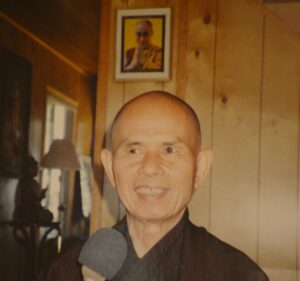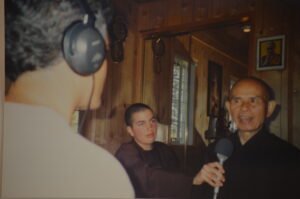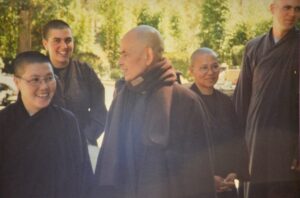PEACE IS EVERY STEP: IN MEMORY OF THICH NHAT HANH
By John Malkin
A version of the following story was published in the Santa Cruz Sentinel on February, 17, 2022, based on an interview with Thich Nhat Hanh in 2002 by John Malkin.
Vietnamese Zen master and peace activist Thich Nhat Hanh passed away on January 22nd. He was 95 years old. A funeral and cremation ceremony took place on January 29th at Vinh Hang Memorial Park outside Huế, Vietnam. Members of the Order of Interbeing – the monastic community Thich Nhat Hanh established with Sister Chan Khong in 1966 – recited some of the venerable teacher’s writings including “Contemplation on No Coming No Going.” This prayer was created for funeral ceremonies and includes, “Since before time, I have been free. Birth and death are only doors through which we pass, sacred thresholds on our journey. Birth and death are a game of hide-and-seek.”
Thay, as Thich Nhat Hanh is known by followers worldwide, had a remarkable Zen gift for using clear language to explain complex Buddhist principles like emptiness, karma, interdependence and impermanence. His calligraphy art work offered short phrases that cut to the heart of the matter like, “You Have Arrived” and “Peace in Myself, Peace in the World.” Thay wrote over one hundred books on meditation and mindfulness including Peace Is Every Step, The Miracle of Mindfulness and No Death, No Fear and he became the world’s second most well-known Buddhist leader after The Dalai Lama.
PEACE AND COMPASSION
In 2002 I had the great honor to do my first interview with Thich Nhat Hanh. We sat on zafu meditation cushions at the Kim Son Monastery in Watsonville and enjoyed drinking tea together. He told me about coming to the U.S.in the early 60’s, “The first thing I learned was that even if you have a lot of money and power and fame, that you can still suffer very deeply. If you don’t have enough peace and compassion within yourself, there is no way that you can be happy.”
Thay revolutionized Buddhism by integrating the practices of meditation and mindfulness with direct action to alleviate suffering. Even as a 16-year-old novice monk in 1942 Thay was already developing Engaged Buddhism and he later established the grassroots organization School of Youth and Social Service with 10,000 volunteers to help rebuild Vietnamese schools and villages devastated by war and poverty. He also led efforts to rescue refugees fleeing Vietnam by boat and helped war veterans develop meditation practices to relieve PTSD symptoms.
ACTION SHOULD BE MEDITATION
Thay told me, “When I was very young, I already believed that Buddhism had to do with addressing the suffering in society. I didn’t know how to do it, but there was a conviction that if you practiced well, then you will be able to do it. During the time when I was a novice, we had already witnessed the suffering caused by the war. We young monks were very eager to learn and practice Buddhism in such a way that we could bring the practice into society.”
He added, “When bombs begin to fall on people, you cannot stay in the meditation hall all of the time because you know what is going on around you, even if the temple has not been bombed. Meditation is about the awareness of what is going on not only in your body, in your feelings, but all around you. You can continue to practice and you can respond to the suffering around you. That was the birth of the manifestation of Engaged Buddhism. You have to learn how to help a wounded child while still practicing mindful breathing, in and out. Action should be meditation at the same time.”
MARTIN LUTHER KING
Thay spoke out against the U.S. war on Vietnam and in 1967 was nominated for the Nobel Peace Prize by Martin Luther King Jr. “Martin Luther King and I had the opportunity to work together. I have a lot of admiration for him,” Thay said. “The last time we met was in Geneva during the Peace Conference called “Paix sur Terre,” Peace on Earth. I was able to tell him that the people in Vietnam were very grateful for him because he had come out against the violence in Vietnam. They considered him to be a great Boddhisatva, working for his own people and supporting us. Unfortunately, three months later he was assassinated.” (April 4, 1968)
THE BUDDHA IS ALREADY HERE
During meditation retreats, Thay would often say that the next Buddha will not manifest as an individual, but will instead arise as a community, a “sangha.” During our interview Thay explained, “The Buddha is already here. If you are mindful enough you can see the Buddha in anything, especially in the sangha.” He added, “The 20th Century was the century of individualism. We don’t want that anymore. We try to live as a community of humans and other species. We want to flow like a river and not a drop of water. The river will surely arrive at the ocean, but a drop of water may evaporate half-way. That is why it’s possible for us to recognize that the presence of the Buddha is the here and the now. Every step, every breath, every word that is spoken or done in mindfulness – that is the manifestation of the Buddha. Don’t look for the Buddha elsewhere. It is in the art of living mindfully every moment of our daily life.”
My second interview with Thay took place near San Diego at Deer Park Monastery, which he established in 2000. In the meditation hall a colorful stained-glass window featured the Sanskrit words “Smirti, Samadhi, Prajna” which represent the three powerful, interrelated realms of “Mindfulness, Concentration and Insight.” On another wall hung a painting of Thay’s calligraphy of a Vietnamese phrase meaning, “No Busyness.”
During the retreat a young boy asked Thay, “Why do we meditate?” The humble Buddhist monk answered with a question of his own, “Why do you eat ice cream?” Thay explained further that meditation is not meant to get you somewhere else. It’s for truly resting peacefully in the present moment instead of being absorbed in consuming, planning or improving.
Thay composed short verses – gathas – to help us arrive in the present moment and appreciate the miracle of life. At meals he suggested this simple verse; “In this food I see clearly the entire universe supporting my existence.” And as a basic meditation, “Breathing in, I am aware that I am breathing in. Breathing out, I am aware that I am breathing out.”
HAPPINESS AND ENLIGHTENMENT
“Happiness and enlightenment are living things and they can grow,” Thay said while we sat together. “The Buddha said that nothing can survive without food. That applies to enlightenment, happiness, sorrow and suffering. Enlightenment is enlightenment about something. Suppose you are drinking tea and you are aware that you are drinking tea. That kind of mindfulness – awareness – of drinking is already a form of enlightenment. There have been many times that you have been drinking tea but you didn’t know that you were drinking. You are absorbed in your worries, in the past or in the future. If you can focus your mind on the act of drinking, then happiness can come while you have some tea.”
Millions of people around the world are mourning the loss of this great leader while simultaneously being filled with deep gratitude that we encountered Thich Nhat Hanh and his rich teachings and powerful activism. Thay reminded me that it was never his plan to bring Buddhism to America. He said that after delivering lectures at New York’s Cornell University in 1966, he was not allowed to return to Vietnam. “I took the opportunity to speak about the suffering that was going on in Vietnam. After that, I learned that they didn’t want me to go home,” Thay recalled. “It was not my intention to come to the West and share Buddhism at all. But because I was forced into exile, an opportunity for sharing presented itself.” The Vietnamese government didn’t allow Thay to return for thirty-four years, until 2005.
COMPASSION IS THE ONLY WAY
After the attacks in New York on September 11, 2001, Thay famously spoke out against war with Iraq and Afghanistan and recommended a practice he’d developed for resolving personal and political conflicts; empathy and deep listening. Thay told me, “Compassion is the only way to reduce violence. Not only within us, but also in the world. Compassion is not something soft. It takes a lot of courage,” he elucidated. “Sometimes you are very scared and you pretend to be strong, but in fact you are very scared. The fact that you are holding a gun does not prove that you are strong. The fact that you are using violence can mean that you are very afraid. That is something that can be easily seen.”
One of his most famous poems – “Please Call Me By My True Names” – is a portrait of empathy with Thay holding a variety of perspectives including that of a mayfly, a frog and both victim and perpetrator of violence; “I am the twelve-year-old girl, refugee on a small boat, who throws herself into the ocean after being raped by a sea pirate. And I am the pirate, my heart not yet capable of seeing and loving… My joy is like Spring, so warm it makes flowers bloom all over the Earth. My pain is like a river of tears, so vast it fills the four oceans.”
Thay co-founded Plum Village Monastery in France in 1982 with Sister Chan Khong and lived there for many years until returning to Vietnam after suffering a major stroke in 2014.
Thich Nhat Hanh dedicated his life to living and presenting the Buddhist practices of peace and wisdom in a clear and immediate way. He taught us that the Buddha’s compassion is in everyone and that we can “take refuge in the Buddha in yourself” and that enlightenment is possible only in the present moment. Wherever you are right now, take a deep breath in and a deep breath out; You have arrived.
Recordings of Thich Nhat Hanh’s memorial ceremonies can be viewed at plumvillage.org/memorial/
INTERVIEW with THICH NHAT HANH by JOHN MALKIN – Recorded at Kim Son Monastery, Watsonville, California – 2002
This interview was originally broadcast in 2002 on Free Radio Santa Cruz.




